Ian Armitage ([email protected])
A major challenge in developing efficient agriculture, improved forest conservation and sustainable food production in Lao PDR is to markedly reduce the practice of slash-and-burn (shifting) cultivation by farmers living in upland and highland localities. This is a policy priority of the Lao Government - - pursuing the reduction of shifting cultivation, including that of cultivating opium poppy, by stabilizing agriculture and creating permanent communities. The Shifting Cultivation Stabilization Project, which is being implemented within a part of Xam Neua District of Houaphanh Province, is a contribution towards achieving this end. One project component is the long-term establishment of agroforestry crops that will generate a diversified and sustainable income for farmers through the production of non-wood forest products (NWFPs).
The Asian Development Bank has helped the project through a loan to the Houaphanh Province. The Houaphanh Provincial Government is implementing the project, with technical assistance from various consultants. The United Nations Office of Drugs and Crime is also providing grant funds and technical assistance.
Natural forests in Houaphanh Province
Natural forests dominate the hilly landscape of Houaphanh Province, although a substantial area is secondary forest that has grown on former shifting cultivation sites, rather than primary forests. Natural forests mainly comprise broadleaved forests (including Castanopsis and Quercus), but conifers also occur (Pinus and Kettelaria).
Given the opportunity to protect and grow under natural ecological succession, regenerating forests eventually become climax vegetation with a stocking density and species composition broadly similar to those of primary forests. However, because of increased community demands upon natural forests and land to grow rice, the regrowth forests rarely reach maturity.
The dominant land-use pattern in Houaphanh Province is shifting cultivation. The forests are cut and burned at intervals ranging from 5 to 20 years. This is based on the traditional cycle of rotational shifting cultivation.
Non-wood forest products derived from Lao forests
One of the main conclusions from various studies made in Lao PDR over the past 10 years is that NWFPs are essential to the Lao national economy, both for subsistence and for trade. NWFPs provide up to 50 percent of the cash income of many rural villages, where the majority of the Lao population lives. NWFPs include various wild animals, mushrooms, bamboo shoots, honey, resins, leaves, bark, fruits, nuts and wild vegetables. They are used as food and are important supplements to cultivated crops for most rural households. Many NWFPs are traded in local markets.
A survey of NWFPs in a part of Houaphanh Province
When the project commenced, little specific information on the current use of NWFPs, or on the project site’s potential to produce these on a sustainable basis, through agroforestry, was available for the Xam Neua District. It was important, therefore, to collect primary information about the production, use and value of the socially and economically important NWFPs in some villages covered by the project, in order to enable realistic planning of the NWFP agroforestry program.
A field survey was designed and undertaken in 2001. The survey collected data on the villages’ most important NWFPs that were collected and sold for cash in 2000; the yields, prices and revenues earned by the major marketed NWFPs and market location for each product; the NWFPs, that were collected but not sold, which were used locally (ranked in order of importance); and the trees, shrubs, herbs or other plant types that could yield potentially marketable NWFPs and could be grown in a sustainable agroforestry system.
Representative data were collected in 27 of the 46 villages in the project area. The survey covered a large, proportional sample of ethnic groups with a wide geographic coverage. Most of the villages comprised the ethnic group that is broadly described as Lao Lum, or Lowland Lao. Only a small number of villages within the project area were Lao Theung (Middle Lao) and Lao Sung (Upland Lao) ethnic groups, or were mixtures of these groups.
For the year 2000, 32 plant species or species groups were recorded as yielding NWFPs, or were reported as having the potential to yield marketable products if markets were available. Plants yielding marketable NWFPs that villagers ranked as the most important were Ngan (Styrax tonkinensis), yielding benzoin resin, One ling (yam) (Polygonum multiflorum) and Mak ko (acorns) (Quercus spp.). One ling has botanical affinities to sweet potato (Ipomoea batatas), which is widely grown as a food crop in parts of Asia and the Pacific. Mak neng (cardamom) (Amomum spp.), Nya baylai (Ludisia discolor) and Ton kho (fan palm) (Livistonia saribus) were also important marketable species in a small number of villages.
The benzoin resin collected from Ngan trees was found to be the most valuable marketable product. Revenue was estimated to be more than Kip500 million (US$50 000) in 2000, in 18 out of the 27 villages visited. By comparison, sales of One ling were estimated at Kip45.6 million (US$4 560) in 2000; Mak neng (cardamom) at Kip55.8 million (US$5 580); and Mak ko (acorns) at Kip71 million (US$7 100). Prices and yields for benzoin and One ling tended to be closely correlated with village accessibility to roads. Villages near existing roads secured higher revenues. Villages that did not sell these products were generally located more than 10 km from roads. Nonetheless, villagers regarded them as potentially marketable products.
Agroforestry designs for NWFPs
Based on the ecological conditions of the Xam Neua district, two NFWP-agroforestry designs were developed, using intercropping techniques:
1. Ngan (overstory) + One ling (understory); all plants are at 2 × 2 m spacing
2. Ngan (overstory) + Mak Neng (understory). Ngan at 2 × 2 m spacing; Mak neng at 1 × 1 m spacing
Variation on these general designs are possible, depending on the farmers’ preferences for local species, site conditions and the farmers’ working experience. The aim is to commence agroforestry development in a simple, though positive way, by establishing pilot crops, each not more than 5 ha, in representative localities. As they gain experience and confidence, farmers may modify the planting designs and introduce other species.
An example of shifting cultivation in Houaphanh, Lao PDR.

Good progress in the establishment of agroforestry practices has been made since early 2003. In May 2004, eight Ngan stands were established in five villages, with a total area of about 7 ha. Growth and tree survival were impressive in three villages (covering 3 ha), where the crops were established on well-cultivated, lower-valley slopes on deep soils. Trees were up to 1 m high after five to seven months, and up to 2 m high after 10 to 12 months. Mak neng (cardamom) was established in two villages using an improved cultivar from China. It is widely planted in Phongsali Province. One ling, intercropped with Ngan, was established in one village in mid-2004, the only example so far where two NWFP agroforestry crops have been interplanted. Prospects for high crop survival and vigorous growth appear to be good. At least six naturally established and well-protected stands of Ngan, mostly five to eight years old, exist in the project area with an aggregate area of about 80 ha. The trees were 16 - 18 m tall and had stem diameters of 20 - 30 cm. Benzoin harvesting is proposed in 2005.
A five-month-old Ngan tree.
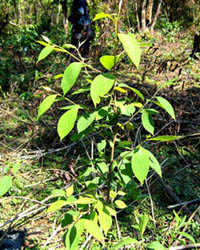
Outlook for NWFP agroforestry
What has been made in developing a basis for agroforestry in Houaphanh Province is a modest but encouraging beginning for the production of NWFPs. The approach described in this article may help in the sustainable production of NWFPs to alleviate poverty in the northeastern corner of Lao PDR.
The author can be contacted at 50 Ranui Terrace, Tawa, Wellington 6006, New Zealand.
Vishal Gupta ([email protected])
Big cardamon intercropped with kadam.

Situated on the northeastern tip of India is the richly forested state of Arunachal Pradesh. The forests mainly consist of evergreens, with some parts having deciduous trees. Most of the forests in this state are community forests under the control of the sparsely populated local communities, the majority of whom are tribal. Due to the remoteness of the area, the tribes continue to practice jhum cultivation, a form of slash-and-burn agriculture. It is estimated that nearly 0.23 million ha of the state is under jhum.
The scheme
To provide local farmers with an alternative to jhum and to rehabilitate the degraded and abandoned jhum lands, the Department of Environment and Forests initiated a scheme called "apnavan," meaning people’s forest. It was conceived as an agroforestry scheme whereby 400 fast-growing trees of timber, fuelwood, fruit and fodder were planted per hectare, at a spacing of 5 × 5 m. The local farmers selected species based on the local agroclimatic conditions, economic value, market dynamics and land suitability. The farmers were encouraged to grow horticultural crops as intercrops.
The main role of the department was to subsidize, promote and facilitate the afforestation efforts. The beneficiaries had the right to sell/use the produce, provided that the rotation age of the tree species was attained. The transit of the produce was covered by the local transit rules. Some 13 645 ha of these plantations were established from 1990 to 1991 and 2000 to 2001.
Current situation
In order to assess the impact of the scheme and the extent to which the objectives were fulfilled, the author conducted a preliminary study in the Dibang Valley Forest Division of the state.
The study area is located between 95°15' and 96°40' E longitude and 27°50' and 29°25' N latitude, roughly at the eastern foothills of the Himalayas. The terrain is gently sloping and broken by numerous streams and rivers. The altitude is between 120 and 250 m a.s.l. The area has a typical tropical climate, marked by conditions of high rainfall, relative humidity and temperatures favoring luxuriant tropical semi-evergreen and moist deciduous forests.
The following agroforestry models were implemented by the local farmers:
Big cardamon intercropped with kadam (Anthocephalus chinensis)
Big cardamon is an important cash crop, which is used locally as a spice. One hectare of this plantation yields nearly 1 000 kg. It has good export potential in the neighboring states and region.
Kadam is a tall, deciduous fast-growing tree. It is self-pruning, bears branches at the top and is a favored species for veneer. Its fruits are edible and its leaves give good fodder. Its timber is used locally for light construction.
Banana, big cardamom, ginger with simul (Bombax ceiba) and sissoo (Dalbergia sissoo)
Banana is one of the most important horticultural crops in the region. One hectare yields 5 tons of ginger, which is used locally as spice and medicine.
Simul is a straight-stemmed deciduous tree that grows on the riversides. The wood is soft and porous and is in great demand in the match industry. It is used to make tea chests. The core veneer is used in plywood making. The cotton is used in upholstery to stuff pillows and cushions. The seeds and flowers are used as cattle feed.
Sissoo is a middle-sized tree that yields very valuable timber. The twigs and leaves are lopped for fodder. It is an important raw material for making furniture.
Pineapple and khokan (Daubanga grandifolia)
Pineapple is one of the major horticultural crops of the region. A hectare yields nearly 7 000 fruits, which not only fetch a good price on the local market but also have good export potential.
Khokan is a tall and very fast-growing tree with a good timber. This tree can reach 22 m with a girth of 138 cm in its 12th year.
Improvement in farm management practices can reduce the financial rotation to less than 10 years.
Future prospects and constraints
The carrying capacity of the land is very low due to the poor soil fertility and primitive agricultural practices. Typically, one hectare of land under subsistence crops, with low inputs (low-yielding seeds, no fertilizers, long fallow periods and one crop per year) can support one or two persons. With intermediate and high agricultural inputs (e.g. high-yielding varieties, multiple cropping and application of fertilizers), a hectare could support four to seven persons.
Planting cash crops as an alternative to jhum is emphasized because of its low-volume and high-value characteristics. However, the downside is that it is a high-input system, which requires adequate financing and a good marketing infrastructure. The relatively well-off and progressive farmers already practice this system. However, most farmers use inferior planting stock and are financially unable to market their produce on their own.
Soley Lingi in his Apnavan plantation of banana, big cardamon, ginger with simul (left).
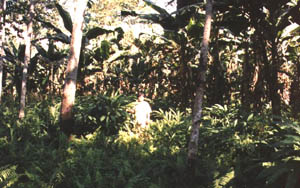
A seven-year-old Khokan apnavan plantation (right).
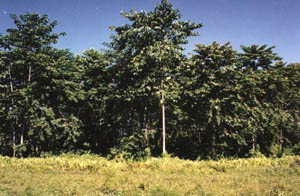
The generally poor marketing infrastructure forces these farmers to sell their produce either at the local market (haat) or to the middlemen who give low remuneration.
Further studies are needed to determine additional beneficial tree-crop combinations. Also, suitable plantation models need to be standardized based on the latest scientific techniques, suited to local norms.
The author can be contacted at the Seppa Forest Division, Seppa -790 102, Arunachal Pradesh, India.
Patricia Shanley ([email protected]) and Sarah A. Laird ([email protected])
A considerable amount of research is being undertaken to assess and characterize biodiversity and the associated resource management systems. This research yields information critical to the design of conservation programs, national strategies for biodiversity conservation and furthers scientific understanding of threatened ecosystems. However, researchers and research institutions generally regard the scientific process complete once an article is sent to press. As a result, most of the information and scientific understanding generated by research remains in the hands of scientists, academics and policy makers. Research programs are rarely designed to incorporate the resource management needs of local groups, nor are the results put in a form that communities can utilize when making resource management decisions. However, local groups are widely considered key stewards and stakeholders in biodiversity and forest conservation today.
In part, this situation results from the fact that the outlook and skills necessary to extend and disseminate results are often not found within the organizations that collect and analyze scientific data. Education and extension groups in the industrialized North acquire scientific data and make valuable use of them in their outreach programs. However, these types of organizations are traditionally small and under-funded in the poorer and more biologically diverse regions of the world.
Governments, conservation organizations, researchers and companies often promote or make land-use decisions without fully informing or involving the local populations most affected. At the same time, groups living in close proximity to forests or high biodiversity zones are often badly in need of scientific data that can assist them in negotiations with logging companies, developing management plans for community forests, assessing the relative value of a given forest area for non-timber forest products versus agriculture and so on. Increasingly drawn into national and global economies and politics, remote groups more than ever need information and tools to effectively participate and negotiate their position in this broadened context.
Traditionally considered distinct from science, education and extension can effectively be twinned with research through institutional or departmental collaboration. Many researchers do not have the skills or interest to translate and transmit their data to local groups. However, if they are aware of the importance of this activity, they can forge alliances to ensure results. Some researchers integrate science and extension in their research design. The fields of education, development and rural agriculture extension have for decades worked to effectively transfer information to local groups. There is much to be learned from these experiences. Unfortunately, communication between most biodiversity researchers and these professionals has been limited.
This article addresses an often overlooked element of equitable research relationships and an invaluable form of benefit sharing: returning data in forms relevant to local groups and applied conservation.
Why give back?
Most biodiversity researchers feel an affinity to the ecosystems and communities that they study or with whom they work. Indeed, most proposals for biodiversity research include the project’s objectives, their service to these ecosystems and communities. But how do researchers generally propose to make this connection? This is primarily accomplished by understanding and organizing the subjects and by providing information that will influence policy makers and the public. The information can also be adopted by applied conservation projects.
Workshop participants explain the economic return of timber as compared to the value of 500 fruits produced by the same tree.
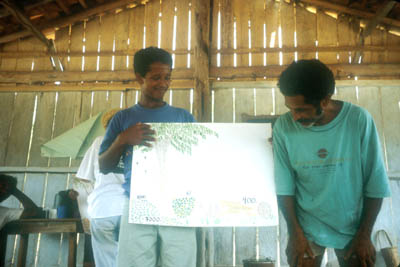
While these are important objectives, another significant way that research results can be magnified to serve communities and conservation is by taking the results and effectively returning them to the groups and communities in or around where they were generated. It has been observed that research designed and directed to serve local resource management needs, shared in ways that allow groups to make informed decisions about long-term resource use, often has surprisingly significant, albeit localized, effects. As we move through conservation fad after conservation trend, often with mixed results, concrete small steps in a positive direction seem an increasingly sufficient objective.
Not only is giving back research results to local stakeholders an important ethical responsibility of researchers, there are also practical reasons to do this that serve immediate scientific and conservation objectives. Some reasons why a researcher should work to give back results in locally relevant forms include:
Local stakeholders represent a critical set of actors who ultimately determine if and how natural resources are used and protected.
The knowledge of local populations is an invaluable perspective in examining data. Their specific commentary and critiques of research can serve as a local test of methods and results.
By returning the results of research locally, the information can be applied immediately. Data fed into the scientific publication circuit can take years to emerge and must compete for the attention of policy makers, in an avalanche of published documents.
Local groups often have key research questions that they want addressed. Their livelihoods and the conservation of local resources and habitats may depend upon concrete answers.
Forms of giving back
Researchers can translate their data into various forms that are immediately relevant to local groups and conservation. In part, the choice of medium depends on the objectives to be served and the intended audience. Local audiences vary and include rural and urban communities and organizations, companies (e.g. loggers, ranchers and commercial agriculture), governments and applied conservation and development projects. Materials should be dynamic and constantly revised in light of feedback and experiences. Some ideas that might be considered include:
Interactive workshops and seminars, these are particularly useful for industry groups, technicians and government officials and can often be loosely structured.
Theatre and traveling shows for rural and urban groups, who often respond better to stories, enacted by fellow community members or visitors.
Exchanges between groups with similar needs and backgrounds but from different geographical regions can be beneficial.
Music is a powerful method of cultural expression.
Lectures may, in some cases, be appropriate in presenting scientific results in a standard academic format, particularly for local research institutions, universities and sometimes government departments.
Manuals and illustrated booklets can be made for various clients. Special attention needs to be given for the development of material for less literate or illiterate users, who require well illustrated literature.
Curricula can be integrated with materials that assist in teaching about the local environment, traditional use of resources and wider environmental concerns.
Coloring books for children in their local language or vernacular are important education and learning tools.
Books can help disseminate information to a broad cross section of society.
Videos can reach broad audiences with powerful visual images and be an excellent training tool.
Lessons learned in giving back
Case studies and other efforts to link the dissemination of research results have yielded some significant lessons and have flagged key issues that researchers might consider in designing their research programs. These include the following:
Conduct locally relevant research, in response to locally articulated needs.
Provide research results in a range of forms during the data collection and analysis process.
Present economic value and units of measurement appropriate for different audiences. To be most effective, this may entail using non-monetary value systems and non-metric local measuring systems.
Integrate traditional and scientific knowledge, which are usually highly complementary, when returning results.
Understand how and why local groups use and manage
resources in the ways that they do - this will help make contributions accurate, relevant and useful.
Provide information on the range of options available to groups, not only those a researcher considers optimal. This will help ensure that recommendations and information are adequately placed in the decision-making reality that local groups face.
Catalyze the learning process with new, useful and challenging concepts. Do not assume that local groups are aware of all possible outcomes and options.
Use innovative and creative ways to transmit information and lessons to relay what is customarily illustrated in scientific graphs and charts or technical language.
Extend dissemination beyond the study area. Neighboring groups and communities often face many similar challenges. Train local collaborators to extend results to neighbors.
Encourage local stakeholders involved in generating information to give back the information, blending in their knowledge, experience and perspectives.
Reflect local social, economic and cultural norms when giving back. Seek to make the audience feel at home with the information and the message.
Villagers use satellite images to detect the impacts of logging.
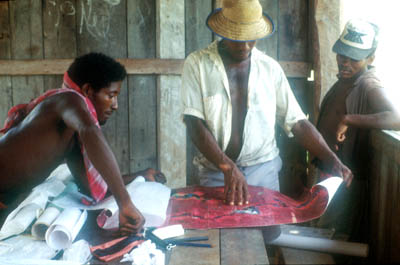
Broader issues associated with giving back
Researchers are often limited by the availability of funds.
Education and extension are an additional cost that many feel they have neither the time nor money to afford.
Researchers tend to look upon information transfer as a "lower" endeavor and not of immediate relevance to their work. Academic promotion systems generally reward neither the multidisciplinary applied work that giving back entails, nor the manuals and other products not entering the peer review system.
Researchers’ and local groups’ time frames are often markedly different. Local groups’ livelihoods or resource-management decisions may require immediate access to information, while journal articles presenting scientific data may take months or years to emerge. Researchers should seek to share preliminary results within a reasonable time frame with local groups.
Medicinal plant workshops emphasize the value of native oils, leaves and bark to treat common ailments.
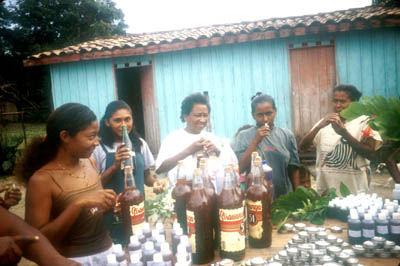
Reprinted, condensed and edited with permission from the publishers of The Overstory as cited: P. Shanley and S.A. Laird. 2004. Giving back: making research results relevant to local groups and conservation (The Overstory #133, published 2 February, 2004). Permanent Agriculture Resources, Holualoa, Hawaii. Web: http://www.overstory.org. Original source: Shanley, P. and S.A. Laird. 2002. "Giving back: making research results relevant to local groups and conservation." In: S.A. Laird (ed), Biodiversity and traditional knowledge: equitable partnerships in practice. Earthscan Publications Ltd. London.
Leila D. Landicho ([email protected])
The increasing interest in the emerging science of agroforestry in the Philippines is evidenced by the growing number of schools offering agroforestry programs. While this proliferation of agroforestry schools aids the country in producing the specialists needed to sustaining upland development, among others, the question on the quality of the curricula remains.
Teachers are considered to be the most important component in the transfer of knowledge, skills and the development of proper attitudes among students. Studies conducted by the Institute of Agroforestry, University of the Philippines Los Baños indicate that most of the faculty members teaching agroforestry courses in the 31 agroforestry schools in the country are not specifically specialized in agroforestry. Rather, they are either specialized in agriculture or forestry. Only two percent of the 400 faculty members have advanced degrees in agroforestry. Most of them are not even full-time agroforestry teachers. Hence, schools often rely on the services of affiliate faculty members from the agriculture and forestry departments to teach agroforestry courses. There were even some schools that tap the services of employees from the Department of Environment and Natural Resources (DENR) to serve as part-time agroforestry instructors. This reality calls for capacity-building programs in agroforestry for teachers - thus the implementation of the National Training of Agroforestry Teachers (NTAT).
NTAT implementation
Apart from enhancing the technical capabilities of agroforestry teachers, NTAT also aims to strengthen their teaching skills. The Southeast Asian Network for Agroforestry Education (SEANAFE) made it possible for the Philippine Agroforestry Education and Research Network (PAFERN) to implement the one-week NTAT course for two consecutive years.
The first time the training was given was from 27 May to 2 June 2001 at the Misamis Oriental State College of Agriculture and Technology in Claveria, Misamis Oriental. There were some 28 participants. The second training was held from 15 to 11 May 2002 at the Aklan State University, Banga, Aklan, with 26 faculty participating.
The course was divided into seven modules, arranged so that participants could apply their knowledge from the previous module(s) in the following module. This entire package was integrated in the final module, prior to the end of the course. Lecture-discussions, role playing, workshops, field visits and individual projects were used in the course’s seven modules:
Module 1: Teaching methods imparted the basic concepts, principles, tools and approaches for effective teaching, with an emphasis on teaching methods and material development.
Module 2: Agroforestry concepts, principles, practices and related programs dealt with the current upland and agroforestry issues and policies, agroforestry systems, production technologies, supportive technologies and income-generating projects.
Module 3: Participatory technology development dealt with the concepts of participatory processes and their implications for agroforestry research, development and extension.
Module 4: Documentation of agroforestry systems covered the techniques in documenting different agroforestry systems adopted and being practiced by farmers.
Module 5: Project planning and management described and explained the project development cycle, the principles of a managerial system, as applied to an organization, the steps in systems managerial analysis, the economic principles of farm management and various approaches to community organization and development for agroforestry.
Module 6: Advances in agroforestry dealts with recent methodologies in agroforestry technology development.
Module 7: Action planning integrated the knowledge from the previous modules in an action plan that focused on effective delivery of agroforestry education, research, extension and/or production programs in the respective institutions of the participants.
The National Training of Agroforestry Teachers (NTAT) enhances the technical capabilities and teaching skills of agroforestry teachers in the Philippines.
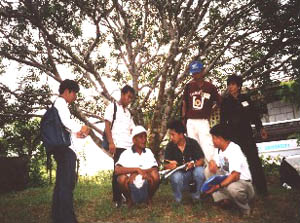
Each participant presented his/her own action plan, which mainly consisted of agroforestry field learning laboratory establishment and improvement, instructional materials and agroforestry course syllabus development and agroforestry systems documentation. These action plans were proposed by the participants for implementation upon returning to their respective institutions.
Revisiting the NTAT training alumni
In 2003, the PAFERN Secretariat followed-up with the alumni of the two NTAT courses. Although most of the action plans were not yet fully implemented due to financial and time constraints. Initial results suggest that NTAT created positive changes at the professional/personal and institutional levels, as expressed by the training alumni and the heads of their respective institutions. According to them, NTAT provided a better understanding and appreciation of agroforestry and its various systems, better delivery of the agroforestry courses, an improved integration of agroforestry concepts in the schools’ research and extension programs, ways for the establishment of on-campus agroforestry demonstration farms, and improved teaching.
The author can be contacted at the UPLB Institute of Agroforestry, College, 4031 Laguna, Philippines.
|
The Olive-Tree And The Fig-Tree The Olive-Tree ridiculed the Fig-Tree because, while she was green all the year round, the Fig-Tree changed its leaves with the seasons. A shower of snow fell upon them, and, finding the Olive full of foliage, it settled upon its branches and broke them down with its weight, at once despoiling it of its beauty and killing the tree. But finding the Fig-Tree denuded of leaves, the snow fell through to the ground, and did not injure it at all. Fable Aesop 620BC - 560BC |